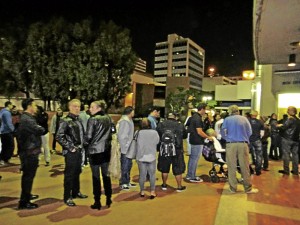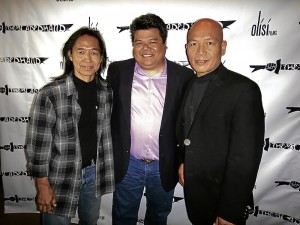Filipino martial arts docu wows US audiences

A QUEUE starts before the screening of Jay Ignacio’s documentary on Filipino martial arts, “The Bladed Hand,” at Aratani Theater in LA. RUBEN V. NEPALES
LOS ANGELES—When Jay Ignacio screened his documentary, “The Bladed Hand: The Global Impact of the Filipino Martial Arts,” recently at Aratani Theater in LA’s Little Tokyo, he drew a good turnout of martial arts experts, devotees and fans.
We met Jay a few years ago when he was filming material for “Bladed…” in LA, so we’ve been following his progress with this documentary that focuses on Filipino martial arts (FMA), its experts in the Philippines and abroad, and its little-known influence on military and law enforcement training in several countries, as well as in Hollywood cinema and television.
“Bladed…” is especially interesting when it shows virtually unheralded old masters who display impressive skills in kali, eskrima or arnis. Some look frail, but they come alive before Jay’s camera and demonstrate swift, agile and expert moves—reminding us that these fascinating, indigenous self-defense traditions could fade away with the passing of these masters.
Jay definitely scores with the appearance of masters like Dan Inosanto and Jeff Imada. We have interviewed Hollywood actors, like Denzel Washington and Forest Whitaker, who said they were trained by, or have been training with, Dan Inosanto. So it was with great interest that we watched Dan in “Bladed…,” which Jay is currently showing across the United States to enthusiastic audiences.
After the LA screening, the audience broke into cheers and applause. Jay, a first-time filmmaker, deserved it. “Bladed…” is an engrossing docu. Jay called outstanding FMA practitioners in the audience and honored them onstage. A spirited Q&A with audience members followed.
Article continues after this advertisement“Filmmaker” is Jay’s latest incarnation. He was a member of a rock band, DaPulis, that recorded on the Sony Music Philippines label. He is also a stand-up comedian. Below are excerpts of our e-mail interview with Jay:
Article continues after this advertisementAs you screen your film across the US, what are you learning from the audience’s reaction and questions?
So far, the American audience has been very enthusiastic about this film. Their excitement continues to grow—I’ve been promoting this film for two years. Now that they’ve seen it, they still can’t get enough of it. This kind of reception is a clear indicator that I did something right.
What are the most surprising comments?
A few said they felt humbled by the generosity and wealth of information shared by the featured masters. I especially love it when people approach me and say: “Thank you very much for putting this film together. I never knew that eskrima had such a cultural and historical significance!”
The film is an eye-opener about the lack of recognition given to FMA.

IGNACIO with martial arts masters Jeff Imada (left) and Virgil Cavada at the screening RUBEN V. NEPALES
It’s very clear that FMA is not given much thought in the Philippines. FMA masters are honored within their circles, but the level of appreciation that their students and colleagues have for them has not crossed over to the mainstream. I produced this documentary with the aim of bringing appreciation for FMA into the Pinoy public’s consciousness, and to honor these people whom I consider cultural treasures.
It’s sad that we’ve lost four masters since you finished the film.
I interviewed Topher Ricketts in San Diego, California, in December 2009, just two weeks after the “Arnis Law” (Republic Act No. 9850, which makes arnis, the martial art that features fighting sticks, as the Philippines’ national sport) was signed. We talked mostly about his personal experience with his teacher, Tatang Ilustrisimo, and he did some demos for me. He was the only one of the four who I am honored to have personally met.
Ben Largusa and Isidro Javier were based in Stockton. I didn’t get to meet them when I was filming. Ernesto Presas was already ill when I started work on the film, so some people were very protective of him and I couldn’t go anywhere near. It’s bad enough to have lost them, but it’s worse when the government that just enacted an “Arnis Law” failed to recognize them.
Please relate what must have been a bittersweet experience for you to go to the home of FMA master Bert Labaniego.
Visiting grand master Bert Labaniego in that shanty in Parañaque was both fun and sad. It’s never a pretty sight to see a living, breathing Filipino cultural treasure living in such conditions. But despite his situation, Bert was very generous with his knowledge and shared with us a lot of incredible techniques, some of which he said he actually got to use to defend himself when he was assaulted in certain public places. The gaunt old man can fight!
Please share with our readers your reply when asked during the Q&A in LA about your funny experiences while shooting this film.
There was one grand master who sang “Delilah” with all his might in front of a karaoke machine. He was so horribly out of tune, but tried to justify the whole exercise by claiming that it was “part of Kali training.” Another guy attempted to make a film within my film while we were at some beach. He proceeded to [tell] me what camera angle to use while he riffed, “Dis is my owshyean, da owshyean op (This is my ocean, the ocean of) Kali. Enter da Warrior!”
We learn from “Bladed…” that some of the martial arts used in films, including Hollywood ones, are of Filipino origin.

FILMMAKER Jay Ignacio (holding microphone) honors martial artists onstage (from left): Nene Gaabucayan, Mike Balancio, Victor Gendrano, Joe Tan, Robert Alonzo, Jesse Abrescy and Earl White. RUBEN V. NEPALES
A lot of Hollywood action films use FMA in their fight scenes, and this is because some of the fight choreographers responsible for these scenes belong to the circle of instructors under Guro Dan Inosanto. Denzel Washington and Forest Whitaker trained under Guro Dan. The others were trained by stunt coordinator Jeff Imada, an Inosanto student himself.
Jon Eusebio, who did the fight scenes for the fourth “Bourne” installment shot in the Philippines, also has Inosanto roots. Tom Cruise and Keri Russell learned their FMA from Master Robert Alonzo, the Fil-Am stunt coordinator for “Mission Impossible: III.” Robert recently became a director and so we’ll surely see some more FMA in his action flicks.
What can we look forward to, in case you get to make “The Bladed Hand 2”?
The first installment of “The Bladed Hand” is an introduction to the subject matter. For the succeeding installments, we will do more in-depth features on a specific subject: The role of Honolulu and Stockton, for example, with regard to the globalization of FMA. My associate producer Sonny Sison is already working on that. We will most likely do a series of FMA documentaries under “The Bladed Hand,” in a manner similar to Ken Burns’ documentaries, where several volumes comprise one set.
(E-mail the columnist at [email protected]. Follow him at https://twitter.com/nepalesruben.)